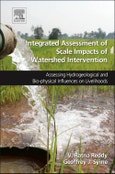Integrated Assessment of Scale Impacts of Watershed Interventions is the outcome of a multi-disciplinary research team of social scientists, hydrologists (groundwater and surface water), modellers; and bio-physical scientists who have worked together over five years to develop an integrated model of the sustainability of biophysical, economic and social impacts of watersheds. Impacts of watershed interventions are assessed at upstream, mid-stream and downstream locations of two hydrological units that are characterised with differential bio-physical attributes. The editors propose that watershed interventions, when integrated with hydro-geology and bio-physical aspects, have greater influence on the resilience of the socio-ecological system. This book takes these aspects in to consideration and in the process provides insights in to watershed design and implementation.
- Integrates hydrogeology, bio-physical, and socioeconomic aspects of watersheds in a hydrological context
- Provides a comprehensive understanding of the impacts of watershed interventions
- Assesses the role of watershed interventions in enhancing household resilience
- Provides hydrological and socio-economic methodologies for design of sustainble watershed interventions including scale and institutional arrangements for implementing and sustaining watershed interventions
Table of Contents
- List of Contributors
- Foreword
- Acknowledgments
- Part I. Setting
- Chapter 1. Introduction
- 1.1. Background
- 1.2. Rainfed Agriculture and WSD in India
- 1.3. Watershed Policies in India
- 1.4. WSD and Importance of Scale
- 1.5. Need for an Integrated Approach
- 1.6. About this Book
- Chapter 2. Analytical Framework, Study Design, and Methodology
- 2.1. Introduction
- 2.2. Strategic Conceptual and Methodological Issues
- 2.3. Assessing Scale Impacts of WSD: An Analytical Framework
- 2.4. Biophysical Modeling
- 2.5. Assessing Socioeconomic Impacts
- 2.6. Model of Integration: The BNs
- 2.7. Equity and Justice Issues
- 2.8. Stakeholder Engagement
- 2.9. Approach and Sampling Design
- 2.10. Profile of Sample Sites
- Chapter 1. Introduction
- Part II. Hydro-geological and Bio-physical Aspects of the Watersheds
- Chapter 3. Investigating Geophysical and Hydrogeological Variabilities and Their Impact on Water Resources in the Context of Meso-Watersheds
- 3.1. Introduction
- 3.2. Study Areas
- 3.3. Materials and Methods
- 3.4. Results and Findings
- 3.5. Discussion
- 3.6. Zones Suitable for Different Types of Artificial Recharge Interventions
- 3.7. Conclusion
- Chapter 4. Application of a Simple Integrated Surface Water and Groundwater Model to Assess Mesoscale Watershed Development
- 4.1. Introduction
- 4.2. Model Development
- 4.3. Site Description and Model Parameterization
- 4.4. Results
- 4.5. Discussion
- 4.6. Conclusions
- Chapter 5. Modeling the Impact of Watershed Development on Water Resources in India
- 5.1. Introduction
- 5.2. Effective and Sustainable WSD: Hydrological Considerations
- 5.3. Study Sites in West Bengal
- 5.4. Data Collection
- 5.5. Modeling Hydrological Response
- 5.6. Application to Andhra Pradesh
- 5.7. Modification of the Original Model
- 5.8. Calibration and Validation Model on the Lakshmipuram Catchment
- 5.9. Applying the Model on an Ungauged Study Site in Andhra Pradesh
- 5.10. Discussion
- 5.11. Conclusion
- Chapter 6. Sustainable Watershed Development Design Methodology
- 6.1. Introduction
- 6.2. Methodology and Approach
- 6.3. Characterization of Biophysical Resources of the Study Sites
- 6.4. Description of HUNs
- 6.5. Land and Water Management Interventions through Watershed Programs
- 6.6. Assessment of Watershed Interventions on Hydrology of Watersheds
- 6.7. Conclusions
- Chapter 3. Investigating Geophysical and Hydrogeological Variabilities and Their Impact on Water Resources in the Context of Meso-Watersheds
- Part III. Socio-economic and Livelihood Impacts of Watersheds
- Chapter 7. Assessing Livelihood Impacts of Watersheds at Scale: An Integrated Approach
- 7.1. Introduction
- 7.2. Approach and Methods
- 7.3. Sample Selection and Profile of the Study Sites
- 7.4. Impact of WSD-The SRL Approach
- 7.5. Impact of WSD on Resilience
- 7.6. Factors Influencing Resilience
- 7.7. Conclusions
- Chapter 8. Evaluating the Determinants of Perceived Drought Resilience: An Empirical Analysis of Farmers' Survival Capabilities in Drought-Prone Regions of South India
- 8.1. Introduction
- 8.2. Methodology and Findings
- 8.3. Testing for the Impact of Watershed Interventions on Drought Resilience
- 8.4. Conclusion
- Chapter 9. Modeling Livelihood Indicators and Household Resilience using Bayesian Networks
- 9.1. Introduction
- 9.2. BNS
- 9.3. Capital Strength and Resilience BNS
- 9.4. Analyzing Social Capital using the BN Submodel
- 9.5. Synthesis
- Chapter 10. Justice and Equity in Watershed Development in Andhra Pradesh
- 10.1. Introduction
- 10.2. A Comparative Evaluation of the Concept of Justice in Water Resources Management in Australia and India: The Role of Participatory and Property Rights Approaches
- 10.3. Collective Action and Property Rights for Poverty Alleviation: A Conceptual Framework Based on the Experience of WSD in Semi-Arid India
- 10.4. Community Views on Collective Action and the Equity of the WSD Process
- 10.5. Conclusion
- Chapter 7. Assessing Livelihood Impacts of Watersheds at Scale: An Integrated Approach
- Part IV. Integrating Science into Policy and Practice
- Chapter 11. High Stakes-Engagement with a Purpose
- 11.1. Introduction
- 11.2. Actual Process Adopted in the Project
- 11.3. Outcomes of the Process Adopted and Lessons Learned
- 11.4. Model for Effective Stakeholder Engagement-Need for and Issues Involved in Closer Engagement with Stakeholders
- Chapter 12. Exploring Implications of Climate, Land Use, and Policy Intervention Scenarios on Water Resources, Livelihoods, and Resilience
- 12.1. Introduction
- 12.2. Analysis Tools
- 12.3. Biophysical Scenarios
- 12.4. Social Scenario
- 12.5. Synthesis
- Chapter 13. Summary and Conclusion
- 13.1. Background
- 13.2. Hydrogeology and Biophysical Aspects
- 13.3. Socioeconomic Implications
- 13.4. The Approach to Integration
- 13.5. Putting Science to Practice
- 13.6. The Way Forward
- Chapter 11. High Stakes-Engagement with a Purpose
- Index








